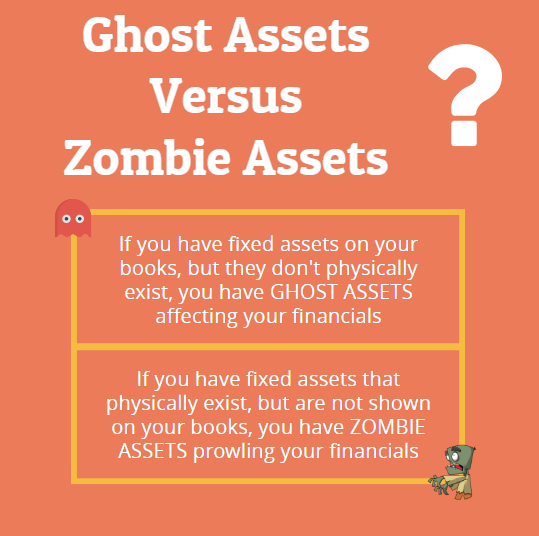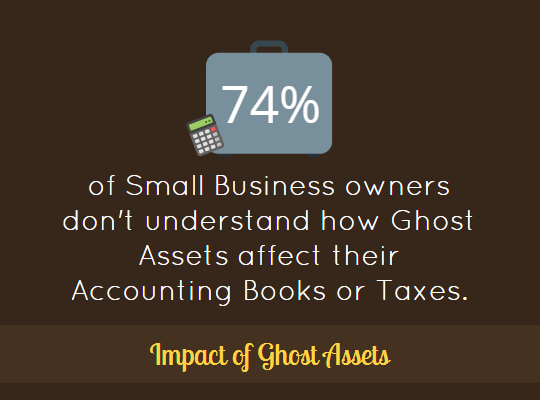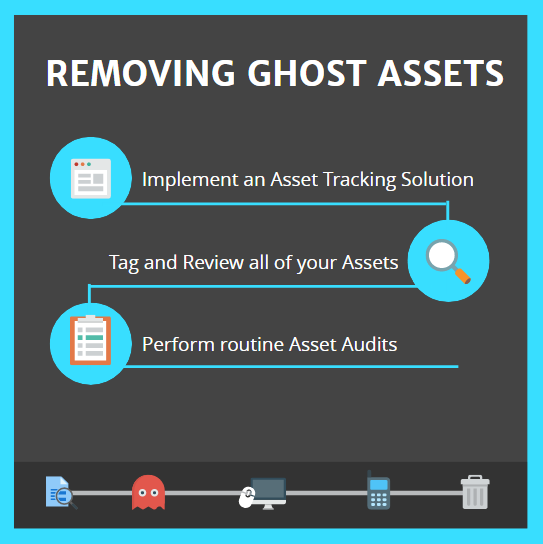Many people cannot resist a good ghost story. However, while a good ghost story is harmless, ghost assets are not. The term ‘ghost asset’ refers to a fixed asset in a general ledger that cannot be accounted for because it is physically (or digitally) missing or otherwise rendered unusable. It has the appearance of ‘vanishing’ unless you have implemented an efficient asset tracking software. It would be fun, but we won’t be looking at the famous TV series, The Supernatural, The Walking Dead, or American Horror Story as examples for fixed assets. Although, one could argue that the equipment used in making these series like cameras, sets, props, etc, could certainly be tracked as fixed assets.

Below we’ll talk about the impact of ghost assets on your company’s accounting books and taxes, and how asset tracking software can help you in tracking and eliminating ghost assets!
Do you have Ghost Assets?
Everyone has ghost assets! Take the following as examples:
- The laptop you placed in service in 2004 that was donated to a local school years ago.
- The transformer that hasn’t run in years but is stored…somewhere, maybe?
- The studio equipment that got replaced, thrice!
Assets become ghosts when some major assets like construction equipment and hardware go missing. How? They get lost, stolen, breaks down, thrown out, or you sell it and it doesn’t get accounted. Enterprises that reconcile assets can identify redundant or rarely used products. According to Gartner, one enterprise saved $100,000 by dropping a product, it was no longer using, and was paying maintenance fees. You may be able to eliminate these ghost assets by conducting a regular inventory of your assets, which include physical assets count, details on manufacturers and vendors.
So what would this mean for your company? It means the value of your company is artificially inflated, when you eliminate ghost assets from your accounting books, the results mean reduced taxes and insurance rates, thus saving your company money. Even your Profit and Loss could take a significant boost when you remove these ghost assets.
Read More: 5 ways to streamline Fixed Asset Management
Impact of Ghost Assets on Accounting Books and Taxes
A large portion of a company’s balance sheets holds the presence of fixed assets that also represent a significant amount of investments for many corporations. Say, if the books show 10% to 30% of fixed assets, which are also the company’s ghost assets, then it might be overpaying by up to 30% on taxes, licenses, and insurance on those assets. On top of that, these kinds of inaccuracies in the reporting causes significant flaws in the overall accuracy of a company’s financials, posing a threat to regulatory compliance.

As per Gartner, companies tend to reduce tax bills on fixed assets by up to 30% if they retire unused assets or what we call them as ‘Ghost Assets’. Discrepancies in Fixed Asset Listing (FAL) can lead to either an over-reporting or under-reporting of assets. These discrepancies can be caused for a number of reasons i.e. unaccounted sale of assets, cannibalization of machinery (that’s one of the common causes in manufacturing and wholesale distribution firms), and decommission of equipment and other assets. This is why communicating with your accountant is the key to avoid such tax implications.
Read More: Taxes made easy with Inventory Control Software | Reduce losses using Asset Management Software
How to Track and Eliminate Ghost Assets?
Let’s start with a straight and correct baseline!
Implement an Asset Tracking Software
One of the most prominent reasons that fail a company in tracking ghosts assets includes the disconnection between various departments within an organization. We’re still there where companies use spreadsheets to record details on assets and equipment. Therefore, it wouldn’t be a shock if we say that these departments including Finance, IT, Operations, and Maintenance teams keep tabs of assets and equipment on separate spreadsheets and registers. This actually makes the process even painful as changes made to one register are not always reflected in the others.
Read More: Is it time to use a centralized asset management solution?
And if the case is that they are updated, then these changes are not made in real-time and there’s a high chance of data duplication and wasted effort. So what’s the solution? To track and eliminate ghost assets, the first step should be to implement an integrated asset tracking software within your company. Using a cloud-based asset tracking software establishes a centralized asset register that is accessible to all the members in a company working in different areas at different locations. If IT department doesn’t need a computer anymore, the finance department can utilize it in another department or write-off if the asset is sold or of no use.
Read More: Why web-based inventory management software beats spreadsheets?
Conduct Physical Asset Inventory
Let’s face it, no business can run without fixed assets. Whether we’re talking about a computer that lets you run your store or a piece of machinery that helps you contribute to a large project, fixed assets are extremely important. However, you also need to know when to let go. You need to understand that some of these fixed assets can be harmful to your business. For this, a company must conduct physical asset inventory regularly. Now that you have implemented asset tracking software within your organization, use that to add and track each inventory item ever bought by your company. Assets must be inventoried on a regular basis. Departments should work together to perform a complete inventory.
To start off, tag all your assets, both physical and digital. Use the right labels for all your assets. This will increase the accuracy of tracking assets and general ledgers. Barcode tagging can dramatically reduce the amount of time spent for asset tracking and auditing in larger enterprises. Tagging will ensure individual identification of all the assets and unique tags (asset identification numbers) will help in differentiating between identical assets. This also helps businesses to track the complete asset lifecycle of an asset i.e from acquisition to disposal, preventing ghost assets records to vanish from the system.
Did you know? As per Gartner, enterprises that do not integrate asset usage and inventory data, often overbuy software licenses for 60% of their portfolio and are non-compliant on 30% of their software.
Read More: Cloud-based Vs. On-premise Inventory Tracking Software
Perform Routine Asset Audits
Till now, you’ve implemented an integrated asset tracking software, conducted an asset inventory and tagged all your assets. But here the part where all the above pays off when you start identifying misplaced or stolen assets. You can’t leave it at that. To ensure ghost assets don’t start showing up again in your inventory, it’s crucial to perform thorough and regular asset audits. You don’t want to pay taxes for equipment that are no longer in use or keep paying for their upkeep.
Asset audits can be easily performed using asset tracking software. You can request audits anytime, asking for detailed confirmations of asset assignments, who had the ownership, and track possession of assets. This will make it easy for you to flag any asset that is no longer accounted for. This also enables businesses to tackle any irregular disappearance of assets and overcome theft instances by increase accountability. You can eliminate assets that have reached their life cycles and identify potential ghost assets. This fights all those company finances and wasted efficiency that ghost assets drain.
Read More: KPIs to track in Asset Management
Benefits of eliminating Ghost Assets using Asset Tracking Software
Missing or unusable assets that are not available are the kind of ghost assets that can cause a company inefficiency and lack of productivity. Because of executives being unaware when critical assets may require replacements, capital budgets are rendered inadequate. When you track them, these are some of the benefits your company can enjoy by eliminating ghost assets:
- Identify potential ghost assets.
- Avoid thefts and asset disappearances within the company.
- Adequate insurance coverage of the assets.
- Streamlined and cost-effective annual updates.
- Accurate accounting of assets for financial reporting.
- Improved budgeting for future capital expenditures.
Choosing the best Asset Tracking Software?
EZOfficeInventory is the leading asset tracking software used by SMBs all over the globe. There is no reason your company should be haunted by ghost assets. Take the time now to set up proper processes.
For more assistance, drop us an email at support@ezo.io.






